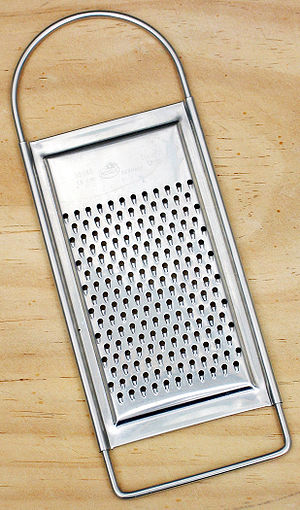What Zest Provides
| Using an orange zester to zest an orange. (Photo credit: Wikipedia) |
However, there is a sub-rind, also known as the pith, which is white in color and directly under the rind. This pith is very bitter and not desirable at all when it comes to cooking. The pith serves only one purpose; to help protect the fruit from predators.
Citrus zest is added in recipes to either add color, intensely strong flavor, or both. There are a number of methods and tools available to harvest the fruit’s zest. You can purchase dried zest in the spice section of the supermarket, but it doesn't hold a candle to the fresh zest you can easily make yourself.
Zesting Techniques
Before starting, be sure to scrub the fruit with a vegetable brush and warm, soapy water. This will help remove any chemicals or other contaminants which may be on the skin. Rinse very well under fresh, cold running water, then dry.
You want to remember when 'zesting' citrus, to be very careful about only zesting, or scratching off, the colorful outside layer. If you start getting into the pith, you have gone too far.
If you are using a traditional hand held zester, you will end up with long, skinny stands of zest. A traditional zester looks almost like a miniature back-scratcher. You can also use a pairing knife, but you will have to be incredibly careful only to get the colorful part of the zest and not the pith. If you don't have a zester or micro-plane grater as listed below, a better choice would be a sharp vegetable peeler - with a careful hand, you can get perfect thin peels of lovely zest. You will probably need to mince or chop them up afterward though.
| A citrus zest grater (may also be used as a general purpose grater). (Photo credit: Wikipedia) |
Of course, if you only have an old fashioned box grater, the type you know from grating cheese, you can zest citrus on that as well. Just try the different grater levels and decide which works best for you. There are times when you might want larger curls of zest and times when you want the zest to be tiny enough to be absorbed into a recipe.
When to Use Zest
Zest is a powerful ingredient you will want to get to know in the kitchen. A little goes a very long way, so you have to know when to use zest. So when should you use zest? Your answer is easy – whenever you want to infuse a dish with incredible layers of citrus flavors.
For example, by folding a little citrus zest into ricotta cheese before making baked ziti or stuffed shells, you get a tangy note that works well with the pasta. Putting lemon or lime zest into olive oil and heating it just until it begins to sizzle will give you an incredible infused olive oil suitable for many uses. You can also mix zest with brown sugar or honey to use as a glaze. Or, try stirring zest into cake or brownie batter for a surprising flavor 'pop' in your favorite dessert!
Zest is an incredible ingredient to lift and brighten many dishes. Considering that we used to just throw the lemon or lime or orange rind away, this is an ingredient that is like 'found money'... or I should say 'found flavor!' Enjoy the zest of citrus to add more zest to your meals.



No comments:
Post a Comment
We welcome comments and suggestions!